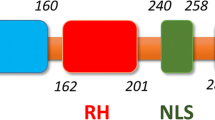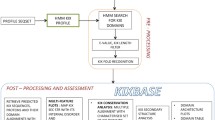Abstract
Cruciform structures are preferential targets for many architectural and regulatory proteins, as well as a number of DNA binding proteins with weak sequence specificity. Some of these proteins are also capable of inducing the formation of cruciform structures upon DNA binding. In this paper we analyzed the amino acid composition of eighteen cruciform binding proteins of Homo sapiens. Comparison with general amino acid frequencies in all human proteins revealed unique differences, with notable enrichment for lysine and serine and/or depletion for alanine, glycine, glutamine, arginine, tyrosine and tryptophan residues. Based on bootstrap resampling and fuzzy cluster analysis, multiple molecular mechanisms of interaction with cruciform DNA structures could be suggested, including those involved in DNA repair, transcription and chromatin regulation. The proteins DEK, HMGB1 and TOP1 in particular formed a very distinctive group. Nonetheless, a strong interaction network connecting nearly all the cruciform binding proteins studied was demonstrated. Data reported here will be very useful for future prediction of new cruciform binding proteins or even construction of predictive tool/web-based application.




Similar content being viewed by others
REFERENCES
Bochman M.L., Paeschke K., Zakian V.A. 2012. DNA secondary structures: Stability and function of G-quadruplex structures. Nat. Rev. Genet. 13, 770–780.
Siddiqui-Jain A., Grand C.L., Bearss D.J., Hurley L.H. 2002. Direct evidence for a G-quadruplex in a promoter region and its targeting with a small molecule to repress c-MYC transcription. Proc. Natl. Acad. Sci. U. S. A. 99, 11593–11598.
Wells R.D. 2007. Non-B DNA conformations, mutagenesis and disease. Trends Biochem. Sci. 32, 271–278.
Zhao J., Bacolla A., Wang G., Vasquez K.M. 2010. Non-B DNA structure-induced genetic instability and evolution. Cell. Mol. Life Sci. 67, 43–62.
Mizuuchi K., Mizuuchi M., Gellert M. 1982. Cruciform structures in palindromic DNA are favored by DNA supercoiling. J. Mol. Biol. 156, 229–243.
Chasovskikh S., Dimtchev A., Smulson M., Dritschilo A. 2005. DNA transitions induced by binding of PARP-1 to cruciform structures in supercoiled plasmids. Cytometry A. 68, 21–27.
Limanskaya O.Y. 2009. Bioinformatic analysis of inverted repeats of coronaviruses genome. Biopolymers Cell. 25, 307–314.
Werbowy K., Cieśliński H., Kur J. 2009. Characterization of a cryptic plasmid pSFKW33 from Shewanella sp. 33B. Plasmid. 62, 44–49.
Pearson C.E., Zorbas H., Price G.B., Zannis-Hadjopoulos M. 1996. Inverted repeats, stem-loops, and cruciforms: Significance for initiation of DNA replication. J. Cell. Biochem. 63, 1–22.
van Holde K., Zlatanova J. 1994. Unusual DNA structures, chromatin and transcription. Bioessays. 16, 59–68.
Zannis-Hadjopoulos M., Frappier L., Khoury M., Price G.B. 1988. Effect of anti-cruciform DNA monoclonal antibodies on DNA replication. EMBO J. 7, 1837.
Waga S., Mizuno S., Yoshida M. 1990. Chromosomal protein HMG1 removes the transcriptional block caused by the cruciform in supercoiled DNA. J. Biol. Chem. 265, 19424–19428.
Alvarez D., Novac O., Callejo M., Ruiz M.T., Price G.B., Zannis-Hadjopoulos M. 2002. 14-3-3σ is a cruciform DNA binding protein and associates in vivo with origins of DNA replication. J. Cell. Biochem. 87, 194–207.
Brázda V., Laister R.C., Jagelská E.B., Arrowsmith C. 2011. Cruciform structures are a common DNA feature important for regulating biological processes. BMC Mol. Biol. 12, 33.
Bianchi M.E., Beltrame M., Paonessa G. 1989. Specific recognition of cruciform DNA by nuclear protein HMG1. Science. 243, 1056.
Waldmann T., Baack M., Richter N., Gruss C. 2003. Structure-specific binding of the proto-oncogene protein DEK to DNA. Nucleic Acids Res. 31, 7003–7010.
Brázda V., Čechová J., Battistin M., Coufal J., Jagelská E.B., Raimondi I., Inga A. 2017. The structure formed by inverted repeats in p53 response elements determines the transactivation activity of p53 protein. Biochem. Biophys. Res. Commun. 483, 516–521.
Jagelská E.B., Pivoňková H., Fojta M., Brázda V. 2010. The potential of the cruciform structure formation as an important factor influencing p53 sequence-specific binding to natural DNA targets. Biochem. Biophys. Res. Commun. 391, 1409–1414.
Cobb A.M., Jackson B.R., Kim E., Bond P.L., Bowater R.P. 2013. Sequence-specific and DNA structure-dependent interactions of Escherichia coli MutS and human p53 with DNA. Anal. Biochem. 442, 51–61.
Pane K., Durante L., Crescenzi O., Cafaro V., Pizzo E., Varcamonti M., Zanfardino A., Izzo V., Di Donato A., Notomista E. 2017. Antimicrobial potency of cationic antimicrobial peptides can be predicted from their amino acid composition: Application to the detection of “cryptic” antimicrobial peptides. J. Theor. Biol. 419, 254–265.
Settanni G., Zhou J., Suo T., Schöttler S., Landfester K., Schmid F., Mailänder V. 2017. Protein corona composition of poly (ethylene glycol)-and poly (phosphoester)-coated nanoparticles correlates strongly with the amino acid composition of the protein surface. Nanoscale. 9, 2138–2144.
Minhas F., Ross E.D., Ben-Hur A. 2017. Amino acid composition predicts prion activity. PLoS Comp. Biol. 13, e1005465.
The UniProt Consortium. 2017. UniProt: The universal protein knowledgebase. Nucleic Acids Res. 45, D158–D169.
Gasteiger E., Hoogland C., Gattiker A., Duvaud S., Wilkins M.R., Appel R.D., Bairoch A. 2005. Protein identification and analysis tools on the ExPASy server. In: The Proteomics Protocols Handbook. Ed. Walker J.M. Humana Press, pp. 571–607.
Tekaia F., Yeramian E., Dujon B. 2002. Amino acid composition of genomes, lifestyles of organisms, and evolutionary trends: A global picture with correspondence analysis. Gene. 297, 51–60.
Vacic V., Uversky V.N., Dunker A.K., Lonardi S. 2007. Composition Profiler: A tool for discovery and visualization of amino acid composition differences. BMC Bioinform. 8, 211.
Liu B., Liu F., Wang X., Chen J., Fang L., Chou K.-C. 2015. Pse-in-One: A web server for generating various modes of pseudo components of DNA, RNA, and protein sequences. Nucleic Acids Res. 43, W65–W71.
Lobanov M.Y., Sokolovskiy I.V., Galzitskaya O.V. 2014. HRaP: Database of occurrence of HomoRepeats and patterns in proteomes. Nucleic Acids Res. 42, D273–D278.
Wei T., Wei M.T. 2016. Package ‘corrplot.’ Statistician. 56, 316–324.
Ishida T., Kinoshita K. 2007. PrDOS: Prediction of disordered protein regions from amino acid sequence. Nucleic Acids Res. 35, W460–W464.
Lobanov M.Y., Sokolovskiy I.V., Galzitskaya O.V. 2013. IsUnstruct: Prediction of the residue status to be ordered or disordered in the protein chain by a method based on the Ising model. J. Biomol. Struct. Dyn. 31, 1034–1043.
Suzuki R., Shimodaira H. 2013. Hierarchical clustering with P-values via multiscale bootstrap resampling. R package. https://cran.r-project.org/web/packages/pvclust/ index.html.
Maechler M., Rousseeuw P., Struyf A. 2014. Package ‘cluster’. R package. https://cran.r-project.org/web/ packages/cluster/index.html.
Szklarczyk D., Franceschini A., Wyder S., Forslund K., Heller D., Huerta-Cepas J., Simonovic M., Roth A., Santos A., Tsafou K.P., Kuhn M., Bork P., Jensen L.J., von Mering C. 2015. STRING v10: Protein–protein interaction networks, integrated over the tree of life. Nucleic Acids Res. 43, D447–D452.
Tompa P. 2002. Intrinsically unstructured proteins. Trends Biochem. Sci. 27, 527–533.
Blander G., Kipnis J., Leal J.F.M., Yu C.-E., Schellenberg G.D., Oren M. 1999. Physical and functional interaction between p53 and the Werner’s syndrome protein. J. Biol. Chemistry. 274, 29463–29469.
Kawai H., Li H., Chun P., Avraham S., Avraham H.K. 2002. Direct interaction between BRCA1 and the estrogen receptor regulates vascular endothelial growth factor (VEGF) transcription and secretion in breast cancer cells. Oncogene. 21, 7730.
Ross E.D., Ben-Hur A. 2017. Amino acid composition predicts prion activity. PLoS Comput. Biol. 13, e1005465.
Sukackaite R., Jensen M.R., Mas P.J., Blackledge M., Buonomo S.B., Hart D.J. 2014. Structural and biophysical characterization of murine rif1 C terminus reveals high specificity for DNA cruciform structures. J. Biol. Chem. 289, 13903–13911.
Adhikari U.K., Rahman M.M. 2016. In silico identification and comparative analyses of active sites of copper containing nitrite reductase (CuNiR) in fungal and bacterial spp. J. Biol. Eng. Res. Rev. 3, 08–18.
Wang L., Huang C., Yang M.Q., Yang J.Y. 2010. BindN+ for accurate prediction of DNA and RNA-binding residues from protein sequence features. BMC Syst. Biol. 4, S3.
Keller H., Kiosze K., Sachsenweger J., Haumann S., Ohlenschläger O., Nuutinen T., Syväoja J.E., Görlach M., Grosse F., Pospiech H. 2014. The intrinsically disordered amino-terminal region of human RecQL4: Multiple DNA-binding domains confer annealing, strand exchange and G4 DNA binding. Nucleic Acids Res. 42, 12614–12627.
Laptenko O., Tong D.R., Manfredi J., Prives C. 2016. The tail that wags the dog: How the disordered C-terminal domain controls the transcriptional activities of the p53 tumor-suppressor protein. Trends Biochem. Sci. 41, 1022–1034.
Benham C.J., Savitt A.G., Bauer W.R. 2002. Extrusion of an imperfect palindrome to a cruciform in superhelical DNA: Complete determination of energetics using a statistical mechanical model. J. Mol. Biol. 316, 563–581.
Reddy K., Tam M., Bowater R.P., Barber M., Tomlinson M., Nichol Edamura K., Wang Y.-H., Pearson C.E. 2011. Determinants of R-loop formation at convergent bidirectionally transcribed trinucleotide repeats. Nucleic Acids Res. 39, 1749–1762.
Lu S., Wang G., Bacolla A., Zhao J., Spitser S., Vasquez K.M. 2015. Short inverted repeats are hotspots for genetic instability: Relevance to cancer genomes. Cell Rep. 10, 1674–1680.
Brázda V., Kolomazník J., Lỳsek J., Hároníková L., Coufal J., Št’astnỳ J. 2016. Palindrome analyser: A new web-based server for predicting and evaluating inverted repeats in nucleotide sequences. Biochem. Biophys. Res. Commun. 478, 1739–1745.
Faller M. 1999. Emboss-palindrome. Online tool. http:// www.bioinformatics.nl/cgi-bin/emboss/help/palindrome.
Ye C., Ji G., Li L., Liang C. 2014. DetectIR: A novel program for detecting perfect and imperfect inverted repeats using complex numbers and vector calculation. PLoS One. 9, e113349.
Fernandes-Alnemri T., Yu J.-W., Wu J., Datta P., Alnemri E.S. 2009. AIM2 activates the inflammasome and cell death in response to cytoplasmic DNA. Nature. 458, 509–513.
Rogacheva M.V., Manhart C.M., Chen C., Guarne A., Surtees J., Alani E. 2014. Mlh1–Mlh3, a meiotic crossover and DNA mismatch repair factor, is a Msh2-Msh3-stimulated endonuclease. J. Biol. Chemistry. 289, 5664–5673.
Monroe D.G., Secreto F.J., Hawse J.R., Subramaniam M., Khosla S., Spelsberg T.C. 2006. Estrogen receptor isoform-specific regulation of the retinoblastoma-binding protein 1 (RBBP1) gene: Roles of AF1 and enhancer elements. J. Biol. Chem. 281, 28596–28604.
Pietrosemoli N., García-Martín J.A., Solano R., Pazos F. 2013. Genome-wide analysis of protein disorder in Arabidopsis thaliana: Implications for plant environmental adaptation. PLoS One. 8, e55524.
Lobanov M.Y., Galzitskaya O.V. 2015. How common is disorder? Occurrence of disordered residues in four domains of life. Int. J. Mol. Sci. 16, 19490–19507.
Stefanovsky V.Y., Moss T. 2015. The cruciform DNA mobility shift assay: A tool to study proteins that recognize bent DNA. In: DNA–Protein Interactions. Eds Leblanc B.P., Rodrigue S. New York: Springer, pp. 195–203.
Čechová J., Lýsek J., Bartas M., Brázda V. 2018. Complex analyses of inverted repeats in mitochondrial genomes revealed their importance and variability. Bioinformatics. https://doi.org/10.1093/bioinformatics/btx729.
Yoshida Y., Izumi H., Torigoe T., Ishiguchi H., Itoh H., Kang D., Kohno K. 2003. P53 physically interacts with mitochondrial transcription factor A and differentially regulates binding to damaged DNA. Cancer Res. 63, 3729–3734.
Zhang H., Meng L.-H., Pommier Y. 2007. Mitochondrial topoisomerases and alternative splicing of the human TOP1mt gene. Biochimie. 89, 474–481.
Ito H., Fujita K., Tagawa K., Chen X., Homma H., Sasabe T., Shimizu J., Shimizu S., Tamura T., Muramatsu S. 2015. HMGB1 facilitates repair of mitochondrial DNA damage and extends the lifespan of mutant ataxin-1 knock-in mice. EMBO Mol. Med. 7, 78–101.
Author information
Authors and Affiliations
Corresponding author
Additional information
The text was submitted by the author(s) in English.
These authors contributed equally to this work.
Rights and permissions
About this article
Cite this article
Bartas, M., Bažantová, P., Brázda, V. et al. Identification of Distinct Amino Acid Composition of Human Cruciform Binding Proteins. Mol Biol 53, 97–106 (2019). https://doi.org/10.1134/S0026893319010023
Received:
Revised:
Accepted:
Published:
Issue Date:
DOI: https://doi.org/10.1134/S0026893319010023




